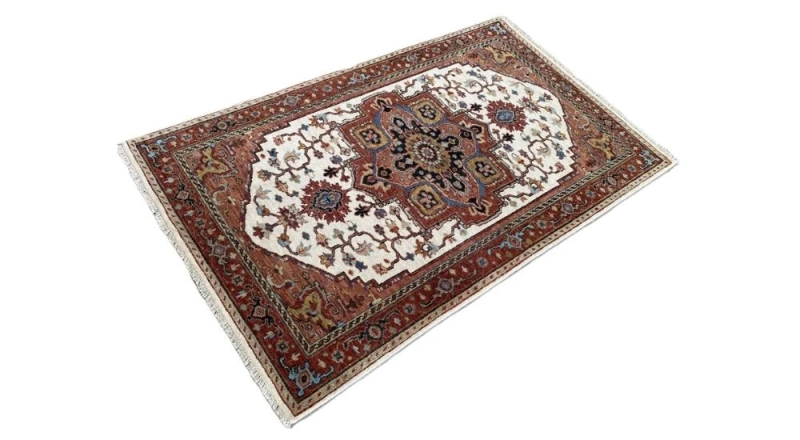You know, those gorgeous, usually expensive Persian rugs? People tend to imagine them in elegant old mansions. Or perhaps they envision them in cobwebbed antique stores. But wait a minute. Those fabulously intricate rugs are way more fascinating than you can possibly know. They're not merely decorative designs. They're really big deals in the art, technology, and international politics world.
First of all, there are some people who are eyeing Persian rugs as investments. We're talking "hard commodities" here. Imagine them like art to walk on. Fine quality, aged rugs tend to appreciate over the years. It's a sort of secret society for art enthusiasts. The entire Oriental rug industry, featuring Persian stunners, is on the upswing. It was worth more than a billion dollars in 2025. Experts predict it to continue growing. So, if you're on the lookout for a novel place to invest your money, a Persian rug could be it. Let’s dive in!
Are Persian Rugs the New Gold?
What makes a rug worth anything? Quality, certainly. Rarity is a big help. Its history and background are important too. And, of course, how well it's been maintained. A well-maintained rug with original colours retains its value best. Delicate weaving and high-quality materials such as wool or silk also add to its value. Having documents that verify its history? That's a big selling point to collectors.
Large auction companies auction them for large sums of money. One rug from the 17th century fetched more than $33 million! Another sold for $9.6 million.
Sure, there are dangers. The market may shift. Something such as the economy or global events might influence prices. You will also have to shell out money for insurance and cleaning. And cheap machine-made rugs are never far away. But unique, old rugs with interesting histories remain valuable. Many collectors hand them down to their heirs.
Tech Meets Tradition
Now, let's discuss how technology is disrupting things. Rug making was a slow business. A designer hand-massaged the design. Someone else transcribed it in a special code. Then, a weaver tied each knot by hand. It took months. It also meant fewer new designs.
But this is changing with computers. You can now create your rug over the internet. Choose the quality, design, fibres, and colour. You can even upload your designs.
Artificial Intelligence, or AI, plays a huge role here. AI can consider previous patterns. It then generates new ones. This is time-saving. AI also assists with colours. It selects shades depending on trends and popularity. You can even employ AI to generate genuinely one-of-a-kind patterns.
The Human Side
The carpet world has a human story, too. Persian carpets were once a massive export of Iran. They ranked only behind oil. Rug exports accounted for more than $2 billion in 1994.
US sanctions took their toll. Exports fell from $426 million in 2017 to less than $40 million by 2024. Previously, the US purchased $80 million of carpets annually.
Other issues contribute to this. Iran's currency has collapsed. This renders rugs too pricey for many locals. Foreign payments are difficult. India, Pakistan, and China produce cheaper rugs. India's market share increased significantly, while Iran's decreased. Smuggled rugs also damage the market. In addition, the industry has not always kept pace with contemporary tastes. Small workshops cannot fulfil large orders.
Iran's government is attempting to assist. They wish for embassies to facilitate exports. The Iran National Carpet Centre also assists the industry.
Increasingly, individuals desire green and moral products. So, fair trade rugs are in demand. It indicates that traditional arts can fulfil contemporary values.
The Secret Language of Threads
Persian rugs are like "woven books." Each knot, every colour, every pattern has a story to tell. They reveal the weaver's faith and sentiment.
Ancient ideas and religions influenced these symbols. Zoroastrianism, a very ancient Persian religion, influenced many motifs. The Tree of Life, for instance, signifies immortality and knowledge. The Boteh, or Paisley, design also originates from Zoroastrian sources. It signifies life and resurrection. Even a highly ancient carpet, dated to the 5th century BCE, displays these symbols.
When Islam came, geometric patterns were usual. They symbolise unity and order. The Mihrab, a prayer niche, symbolises a path to paradise. Green is an Islamic sacred colour. It's used sparingly, usually where individuals won't walk on it. Many patterns also tell of love, protection, and nature.
Let's examine some patterns:
- Tree of Life: Symbolises eternal growth and connection between heaven and earth.
- Boteh (Paisley): Symbolises life, eternity, and rebirth.
- Medallion (Gul): Usually symbolises the sun or moon. It also signifies inner strength.
- Flowers: Lotus symbolises purity. Roses symbolise love. Pomegranates symbolise fertility.
- Animals: Lions signify power. Deer signify grace. Birds signify freedom. Legendary beings such as dragons provide protection.
- Geometric Shapes: Stars and diamonds signify balance and protection.
Rugs in Art and Style
Persian rugs are not only for floors. They've always been art. They used to be hung on walls. Even famous people in history owned them.
- Faig Ahmed: This artist creates rugs that appear "digitally distorted." They may have pixels or melting effects. He designs them using computers. But they're hand-woven. His artwork demonstrates how old concepts evolve rapidly.
- Debbie Lawson: She creates life-size animal sculptures. They "appear" from old rugs. She wraps animal forms in pieces of rug. It appears the animal is part of the rug.
- Esther Elia: Her work utilises the Persian rug as a means of discussing safety. She investigates what being Assyrian today entails. She employs digital drawings in her work.
- Jason Seife: He paints patterns of Persian rugs. He emphasises symmetry and design. He desires to preserve traditions.
Final Words
Social media helps spread the word. Trending hashtags and influencers show rugs to new people. This makes buying a rug feel like a cultural journey. Virtual showrooms also let you see rugs in your home before you buy.
So, Persian rugs are not just old carpets. They are living art. They are part of a big story. They connect history, tech, people, and style. They are truly timeless.


